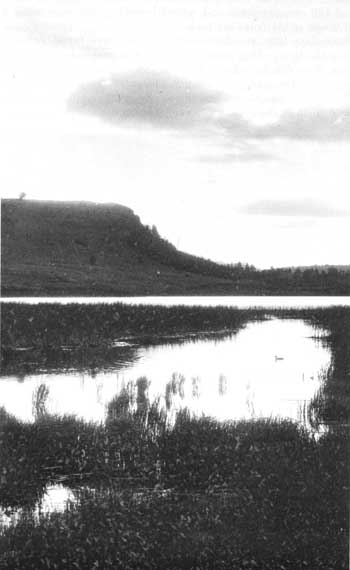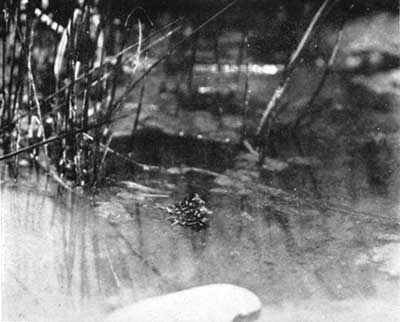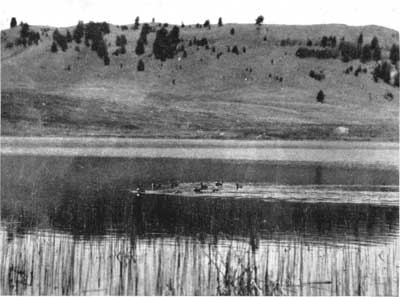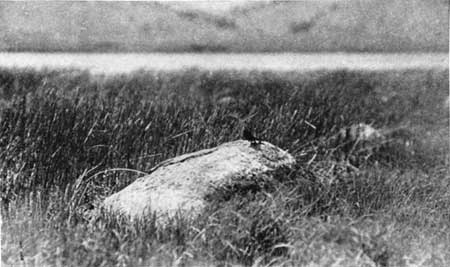![]()

Fauna Series No. 2
![]() Part I
Part I
Fauna of the National Parks
of the United States
PART I
A WILDERNESS-USE TECHNIQUE
By BEN H. THOMPSON
In northwestern Wyoming is a land guarded by mountains. It is a wilderness of forest, swamps, and lakes, broken by cliffs and lofty granite spires, and chiseled by crackling ice and the sunny dripping of water. Long river tentacles reach up to this high plateau from different oceans. In winter it is a land of heavy snow and sweeping sleet, and sometimes the night is whiter than day. Then the elk herds drift down from the sage and aspen valleys where the rivers go to warmer levels. The weasels turn white with little black tips, and the snowshoe rabbits have black-edged ears above muffed feet. Sometimes a great gray owl comes softly out of a wet sky. In spring it is a land of mist-blue forests and sparkling lakes. Then summer haze begins to rise from the forest and makes the great mountains look like bluer shadows in a blue sky. Ocean birds come sailing in to nest in unseen swamps. There is the minute whistle of ducks, the call of geese, and the "weer" cry of gulls. The marsh grass grows in seeping ground and the forest blooms; the pond lilies push their soft yellow lamps above water, and sage and lupine bask in the sun.
Into this land people go for the love of it and to learn its ways. To save this wilderness just as it was "for the benefit and enjoyment of the people", a portion of it was established as Yellowstone National Park.
Here is a thing so glorious that it threatens to be impossible. How can the secret beauty of wilderness be opened to the people and remain unspoiled? This is the greatest question we have to meet if we are to save this and every other national park as truly primitive areas. At once we are faced with the thing so aptly expressed by Leopold:1
The salient geographic character of out-door recreation, to any mind, is that recreational use is self-destructive. The more people are concentrated on a given area, the less is the chance of their finding what they seek.
It seems that what we most need is the technique of using a wilderness without spoiling it. Roads and living accommodations have been constructed in these wilderness places to make them habitable for man. Roads have cut through forests and hills, have bridged rivers and marshes, have clean-cut the feathery margins of lakes. Buildings, erupting from the age-blended scene, have been set up in the midst of sacred areas. All this was perceived years ago, and a remarkable technique has since been developing to blend buildings, roads, and bridges with the scene and to save sacred areas from all development. But the main problem still confronts us—to preserve the wilderness character of humanly utilized wilderness.
A step so simple as to be almost overlooked, yet perhaps far-reaching in its implications, has been made.
An old road in Yellowstone is to be improved and partly relocated. Near the brink of the Lamar River in northeastern Yellowstone, in the direct route of the new road, a small lake spreads between low glacial mounds. At evening, the mirrored hills and sky take on a shining luster within the margin of the lake. The picture looks so quiet, but from the tules around its edge comes a medley of squalls, chucks, squeaks, and ratchety sounds. From time to time the chorus rises, as two waterfowl with slapping feet and wings run across the water, shattering its picture into a thousand disconnected pieces. Then small dusky creatures bob again back to the tules, and the picture draws its shining self together once more.

Figure 13. – The lake.
(Photograph taken June 19,
1930, at Trumpeter Lake, Yellowstone. Wildlife Division No.
888.)
The lake is not spectacular nor famed for its beauty. It is simply one of many lakes in the region where wild fowl nest and wild animals come timidly to drink. But the question arose—and this is perhaps the germ of a new technique—whether the proposed road should girdle the lake or stay entirely away from it to avoid disturbance of the nesting waterfowl. In other words, was the wildlife of this lake important enough to man, for aesthetic recreation, to induce him to change the course of a proposed highway? The question naturally hinged on the extent and variety of waterfowl utilization of the lake. Observations made at the lake over a period of years have disclosed the following:
Pied-billed grebes, not known in the park before, in recent years have been found nesting among the tules in this lake. Here they glean the mud-gray tule stems from the lake bottom and construct their barely floating nests. Each nest is hardly more discernible than a shadow on the water and can be easily mistaken for a tiny mass of half sunken débris. But neatly hidden beneath a few wet-clinging tule stems, rest the several roundish white eggs, sheltered from the sun and possible enemies while the nesting bird feeds out in the lake. One swampy afternoon a sharp and sudden hailstorm broke over the lake, pelted its glossy surface into bobbing chessmen and wilted the bird songs in the tules. With the first great drops of the shower, the silent snake-like head of the grebe suddenly rose in the water, the bird crawled onto her nest, carefully nosed the covering back and settled herself on the eggs while the hail drops rolled from her back.
Some days later two little downy grebes were found swimming among the tules. They were captured, photographed, released. No sooner than the intruders' departure, four loudly cawing ravens swooped on the lake, flew away with one of the baby grebes, and the other one was never seen again. So much for the good intentions of man in the grebe's precarious haunt!
Almost certainly, these timid, elusive birds would not frequent the lake if the road were built by its brink.

Figure 14. – Two little, downy pied-billed grebes were
found swimming among the tules.
(Photograph taken June 30, 1930,
at Trumpeter Lake, Yellowstone. Wildlife Division No.
1363.)
Year after year a pair of trumpeter swans returns with the lengthening days of April to rebuild their huge half-floating nest of dry tules stems. More like a haycock it looks as it lies nakedly on the lake in early spring. By the time the downy white cygnets hatch, after 40 days of hazardous incubation, green tules screen the nest and birds from the lake shore. So wary are these great white birds that they are easily frightened from the nest. At such times—in other nests—ravens have been known to break the eggs, and an otter has been watched as it rolled in the nest and tore it to pieces. In spite of such vicissitudes, this pair of trumpeter swans has raised six young swans during the last 3 years. There are probably fewer than a hundred trumpeter swans left in the United States. This little lake is of vital importance to the species.
Common Canada geese frequent the lake, although no nests have been found. Common mallards nest at the lake each year and usually may be seen with their shuttling ducklings, foraging somewhere in the tules. Pintails, scaups, and Barrow golden-eyes glean the marshes day after day, and ruddy ducks court and fight like pirates.

Figure 15. – . . . and ruddy ducks court and fight like
pirates.
(Photograph taken June 12, 1931, at Trumpeter Lake,
Yellowstone. Wildlife Division No.
2316.)
Each year, after long search, the shadowy form of the little sora is seen as it creeps through the whispering marsh tangle. At least three pairs of Wilson phalaropes have nested at the lake in 1 year. They are the most evasive of all the lake inhabitants. Now and then a solitary sandpiper proclaims its presence by a flying flash of its tail, but more often the spotted sandpiper flickers from bank to bank to lead you from its nest. Two killdeers nest near the muskrat's house, their plaintive cries convincing you that two fuzzy babies are crouched near you perhaps in a buffalo track. The inexorable coots fight and squawk day and night. Their clumsy nests, built like fire houses, with driveway from nest floor to water, encircle the lake. Prolific, they people the marsh with innumerable black babies.
Yellow-headed blackbirds outnumber them all. Like a yellow-vested orchestra, they maintain the din and the clatter. Forty-three of their nests were found at the lake one summer. Of these, 33 were empty. Of the remainder, only 3 contained 4 eggs each when the census was taken. Their rate of reproduction at this particular lake cannot be great. Three pairs of red-winged blackbirds nested at the lake the same year. Their nests were destroyed by some unknown factor before the eggs hatched. But each year the red-wings return. Nevada Savannah sparrows and Lincoln sparrows nest in the grass by the lake shore. Rock wrens and yellow-throats sing from the surrounding hillsides.
A total of 73 nests was found at the lake one year. This may seem an amazing number for so small a community but it is probably representative of many similar marsh-lakes in the park.

Figure 16. – The red-winged blackbird's nest was
destroyed by some unknown factor before the eggs hatched, but each
year the red-wings return.
(Photograph taken June 16, 1930, at
Trumpeter Lake, Yellowstone. Wildlife Division No.
657.)
There seems to be a neat signal code between birds and mammals of the lake region. No matter how stealthily the lake is stalked, one's secret approach is usually heralded by the snort of an antelope, the whistle of a marmot, the squeak of a ground squirrel. After much foolish labor one peers cautiously over the last hillcrest to find every bird in the lake alert for danger. What the effect would be of highway traffic thrust into such a delicately poised protective system can only be conjectured, but it would probably deaden its efficiency.
Thus we briefly sketch the lake's bluebook. Only the birds which are most confined to the lake habitat have been mentioned. A host of others is wrapped in the lake's ecologic community. They, too, add to the recreational values but are not directly connected with the problem under consideration.
Since the lake is neither spectacular nor uncommon—is not one of the outstanding manifestations of primitive nature—should so much consideration be given to it? Why not follow the already surveyed course of the proposed road?
National parks are created where the outstanding examples of primitive nature are to be found. Roads and accommodations are constructed in them to make them available to the people—so far, so good. But when we come to make the wilderness itself available to the people, we must first arrive at some idea of that which we seek, then develop the technique for accomplishing our goal. As far as wildlife in the wilderness is concerned, perhaps the greatest spectacle is not a flock of thousands of birds on a baited sanctuary, but the one mother grebe covering her nest while the hail drops roll from her back. We cannot build highways to see these things. We can build highways to bring people near enough that they can see these things by exerting a moderate amount of their own individual energy and ingenuity.
Applying this thought to the lake and proposed highway, we would be more apt to attain the thing we seek if we kept this little lake away from the road, where those may go who care to and observe the birds which live there. There is no need to make it available to any others.
Birds are seen constantly along roadsides in the park, as portrayed in the preceding article by Wright. Furthermore, as he has suggested, wildlife tends to cleave as closely as possible to its natural mode of living where the innovations of man do not actually force it out of its normal habitat. Even such disruptive events as the construction and utilization of modern highways in Yellowstone leave the major portion of the native bird life apparently undisturbed. In other words, the wilderness is persistent.
It may be that the disrupting effect of a modern highway in a wilderness is more psychological than zoological. If such is the case, that it is worth considering, too. But in the particular case of this little lake and the proposed highway, there is grave doubt that a lake-shore highway would be of any benefit to either the nesting swans or grebes, and might result in the loss of several other species at the lake, even though there would still be enough birds left to present an interesting, primitive spectacle from the road.
These factors were considered, primarily as affecting the trumpeter swans but also as affecting some of the other nesting birds of the lake. An order was issued that the road should not follow the lake shore.
This perhaps seems like "much ado". Nevertheless, it is an advancement in the technique of utilizing the wilderness and still preserving it. What will the future of such a technique be? I am tempted to speculate.
It will depend in great measure upon the things we learn about wilderness as an organism. Based upon these findings, accommodations for human convenience must be so constructed that they will exert a minimum of intrusion. Otherwise, man loses the things he seeks. It will depend upon the effects of roadways, trails, sanitation, roadside clean up, and other developments, as they affect plant and animal communities, soil, water percolation, etc. It will depend upon the effect of man's presence in large numbers in the wilderness. The accumulation of such knowledge may result in the restoration of much larger tracts of untouched wilderness than we have now. It may result in a greater concentration of development areas than we now have, with perhaps certain lines of development abandoned. Undoubtedly the future generations will be more adept in the art of this technique than the present, and they will be grateful for large tracts of wilderness wherein they may develop new values which our present limited technique has left untouched.
From the psychological angle we have equally as much to learn. It is enough to suggest that perhaps a certain minimum area of undeveloped wilderness may be found necessary for the aesthetic recreation of the individual; that a certain width and type of road may not be exceeded without suffering definite loss of wilderness character along its course; that beyond a certain degree in refinement of roads and living accommodations we are as effectively removed from being in the wilderness as though a glass enclosed us; that guided trips and excursions must be limited to certain numbers of participants, beyond which we face the law of diminishing returns in wilderness enjoyment.
At any rate, the decision at the lake was an indication of the growth of a wilderness-use technique in the national parks—an attempt to keep these places as they were when the fur trappers first explored them, and yet to open their treasures to all people.
1 Conservation Economics, by Aide Leopold, Journal of Forestry, vol. XXXII, no. 5, 1934, pp. 537-544.
Top
Last Modified: Tues, Feb 1 2000 07:08:48 pm PDT
http://www.cr.nps.gov/history/online_books/fauna2/fauna2d.htm
![]()